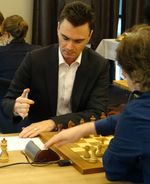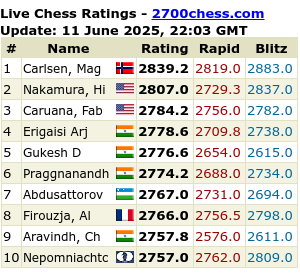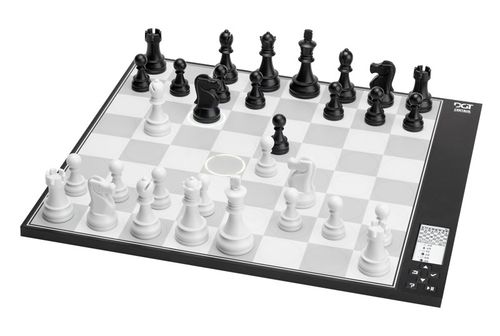Yochanan Afek analysis the Dutch Championship
Attending the Dutch championships in Manor hotel Amsterdam was a surprisingly pleasant experience. Planning a symbolic half an hour visit I found myself twice staying for the entire sessions which were truly rewarding in terms of superb organization as well as of lots of over the board exciting chess. I was invited by schakers.info to introduce my favorite games in the event and here is my selection:
###pgn###
[Event “ch-NED 2014”]
[Site “Amsterdam NED”]
[Date “2014.07.11”]
[Round “5.4”]
[White “Bok, Benjamin”]
[Black “Van Wely, Loek”]
[Result “1-0”]
[ECO “B90”]
[WhiteElo “2586”]
[BlackElo “2657”]
[Annotator “,Yochanan”]
[PlyCount “97”]
[EventDate “2014.07.06”]
1. e4 c5 2. Nf3 d6 3. d4 cxd4 4. Nxd4 Nf6 5. Nc3 a6 6.Be3 e5 {Preferring this continuation over the more common 6…e6, Black seeks a smoother development and early space achievements. Since in chess too there are no free meals the squares d6 and d5 are permanently weakened as they are cannot any longer be defended by fellow pawns.} 7. Nf3 Be7 (7… Be6 {could have been more adequate against white’s next move had black not possessed the annoying reply 8.Ng5.}) 8. Bc4 O-O 9. O-O Nc6 (9… b5 $4 {is premature in view of} 10. Bd5 $1 {and wins.}) 10. Re1 {The more natural-looking 10.Qe2 would obstruct the optional retreat of the white bishop, when attacked to the parking spot f1.} b5 11. Bf1 $5 (11. Bb3 {is perfectly playable though white prefers not to trade his Bishop at this point following} Be6 {hoping to use it in future struggle over black’s weakened white squares.} ({Or} 11… Na5)) 11… Rb8 12. Bg5 Ng4 13. Bc1 $1 {The double Bishop retreat to their initial base makes an aesthetic impression. Nevertheless aesthetics is by no means the reasoning for such a retreat. It’s rather the wish to keep the bishops on the board awaiting their relocation in due course without obstructing the route of fellow pieces.} Nf6 14. Bg5 Ng4 15. Bc1 Nf6 {A kind of a mutual check out of the opponent’s intention but also a common practice of repetition to save some clock time for the more critical stages of the battle.} 16. a4 b4 17. Nd5 Nxd5 18. exd5 ({Some of you might suggest that} 18. Qxd5 {would keep the “d” file as well as the diagonal open however those sharp eyed among you would surely notice the strong reply} Be6 $1 19. Qd3 ({Not} 19. Qxc6 $4 Rb6 $1 {and the queen is trapped!}) 19… a5 20. Be3 h6 21. Rad1 Qc7 {with comfortable equality.}) 18… Na5 19. Bd2 $5 f5 20. c3 b3 ({The alternative} 20… bxc3 21. Bxc3 Nb3 {might lead to an exciting adventure:} 22. Nxe5 $5 (22. Ra3 Nc5 {is fine for Black}) 22… dxe5 23. Bc4 Nxa1 24. d6+ Kh8 25. dxe7 Qxe7 26. Bxe5 Nc2 27. Qxc2 Bb7 {with mutual chances}) 21. c4 Bf6 22. Bc3 Qc7 23. c5 $3 {The double exclamation mark is for the brilliant idea . Defending the attacked pawn would enable the black knight to take over the stronghold c5. Sacrificing the pawn on the other hand would allow the time precisely for obstructing this square and moreover to leave the “c” file open for the White rooks which would prove critical in our game.} Qxc5 24. Rc1 Qb6 25. Qd2 Nb7 26. a5 Qd8 27. Bb4 $1 {That’s it! the white knight is deprived of it’s goal square c5 and remains misplaced.} g5 $6 {An over aggressive and highly committal decision which could be effectively met by an equally vigorous response.} ({ Returning the favor by} 27… Nc5 28. Bxc5 dxc5 29. Nxe5 ({Not} 29. Rxc5 $2 e4 ) 29… Qd6 30. Nc6 Ra8 (30… Rb7 31. Bxa6) 31. Bc4 {would leave white with a strong passer and black with vulnerable pawns.}) ({Correct, however, was} 27… e4 $1 28. Nd4 Bg5 $1 29. Re3 Ra8 30. Nxb3 Qe7 {and black seems OK having sufficient counter-play.}) 28. Qc3 ({vacating a flight square d2 for his threatened knight, White rushes to profit from the open file which is under his full control. Quite sensible yet he could probably react even more effectively with} 28. h4 $1 gxh4 (28… g4 29. Ng5) 29. Bxa6 e4 30. Nd4 Bg5 31. Re3 Qf6 32. Nc6 Ra8 33. Bc4 {which looks favorable for white thanks to the new mighty passer on a5.}) 28… g4 29. Nd2 e4 30. Qxb3 Nc5 31. Qa3 Bd4 32. Bc3 Qf6 33. b4 $1 Nd7 $2 ({It is certainly not easy to navigate in this complex position. Nevertheless Black should have seek a more active defense which would offer better counter chances by:} 33… Nd3 $1 34. Bxd3 exd3 35. Bxd4 Qxd4 36. Rc7 Rb7 37. Rc4 Qxd5 38. Qc3 Bd7 39. Rd4 Qf7 40. Rxd6 Bb5 {where black finally seems to consolidate his highly risky position.}) 34. Bxd4 Qxd4 35. Nc4 Qf6 36. Qg3 $1 Rxb4 $2 {The decisive error after which the fall of d6 pawn signals black’s collapse. He should have tried to hold by} ( 36… Ne5 37. Nxe5 Qxe5 38. Qxe5 dxe5 {though following} 39. Rc7 {it already looks bad enough.}) 37. Nxd6 $18 Rb8 38. Rc6 Qg7 39. Rc7 f4 40. Qh4 e3 41. Rec1 {Black is defeated in all fronts and in view of the unavoidable invasion he could have already called it a day. The rest of the game needs no further commentary.} exf2+ 42. Kh1 g3 43. Nxc8 Re8 44. Nb6 Re1 45. Nxd7 Rf8 46. hxg3 fxg3 47. d6 Re6 48. Nxf8 Qh6 49. Rxh7 1-0
%%%pgn%%%
In order to make some justice also with the fresh champion I decided to add his charming miniature from the penultimate round:
###pgn###
[Event “ch-NED 2014”]
[Site “Amsterdam NED”]
[Date “2014.07.12”]
[Round “6.1”]
[White “Van Wely, Loek”]
[Black “L’Ami, Erwin”]
[Result “1-0”]
[ECO “C40”]
[WhiteElo “2657”]
[BlackElo “2650”]
[Annotator “,Yochanan”]
[PlyCount “27”]
[EventDate “2014.07.06”]
1. Nf3 f5 2. d3 Nc6 3. e4 e5 4. g3 Nf6 5. Bg2 fxe4 6. dxe4 Bc5 7. Nc3 O-O 8. O-O {Not the most ambitious response to the Dutch defense however apparently not without its poisonous potential.} a6 ({Black wants to secure his dark squared Bishop and yet following} 8… d6 9. Na4 Bb6 10. Nxb6 axb6 $11 {he obtains full equality pretty comfortably.}) 9. Nd5 $1 Nxe4 $2 ({Greed! Black should complete his development by} 9… d6 {though after} 10. Bg5 Be6 11. c3 {white is already slightly better owing to the unpleasant pin as well as his space advantage.}) 10. Qe2 $1 Nxf2 $4 ({Entirely overlooking white’s next move. Black could still deviate to:} 10… Nd6 11. Bg5 Nd4 12. Qd2 $1 Ne4 (12… Nxf3+ 13.
Bxf3 Nc4 14. Qc1 $1 $18) 13. Qxd4 $1 exd4 14. Bxd8 Rxd8 15. Nxc7 Rb8 16. Rad1 $14 {where Black loses “just” a pawn but might count on his Bishop pair to put tougher resistance.}) 11. Qc4 $1 {All of a sudden the tables are turned on. The best way for white to counter the new born Black battery is to create his
own, much more lethal one!} Ba7 ({Other tries are no better:} 11… d6 12. Ne3+ Kh8 13. Rxf2 $16) (11… Ne4+ 12. Kh1 Bd4 13. Nxd4 Rxf1+ 14. Qxf1 Nxg3+ 15. hxg3 Nxd4 16. c3 Ne6 17. Be3 $16) 12. Bg5 $3 {This quiet move under two firing batteries is amazingly the only winning way!} b5 ({Since} 12… Ne4+ 13. Kh1 Nxg5 14. Nxg5 Kh8 15. Rxf8+ Qxf8 16. Rf1 $18 Bf2 17. Nxc7 {leaves black no hope.}) 13. Ne7+ Kh8 14. Ng6+ $1 ({The final accord! In view of} 14. Ng6+ hxg6 15. Qh4+ Kg8 16. Bxd8 $18 {it’s time to throw in the towel.}) 1-0
%%%pgn%%%
Women tournament
I must admit that I had much harder time selecting a game from the ladies competition. Indeed there was plenty of fighting chess here too and we have a well deserved new queen of the younger guard, however it was not an easy task to pick up an exemplary game of high quality. Nevertheless I find the following endgame quite appealing owing to its instructive merits and surprising finesses: Black, a whole piece ahead, is possibly already celebrating her success and thus misses the essential sudulties in this innocent looking position.
###pgn###
[Event “NK Vrouwen”]
[Site “Amsterdam”]
[Date “2014.07.06”]
[Round “1”]
[White “De Jong-Muhren, Bianca”]
[Black “Paulet, Iozefina”]
[Result “1/2-1/2”]
[ECO “B52”]
[WhiteElo “2296”]
[BlackElo “2227”]
[Annotator “Fedex”]
[PlyCount “189”]
[EventDate “2014.07.06”]
[EventRounds “7”]
[EventCountry “NED”]
[TimeControl “6000+1340”]
[WhiteClock “0:05:48”]
[BlackClock “0:01:01”]
1. e4 c5 2. Nf3 d6 3. Bb5+ Bd7 4. Bxd7+ Qxd7 5. O-O Nf6 6. Re1 e6 7. c3 Be7 8.
d4 cxd4 9. cxd4 O-O 10. Nc3 d5 11. e5 Ne8 12. h4 Nc6 13. Qd3 f6 14. exf6 Bxf6
15. Bg5 Nd6 16. Rad1 Qf7 17. Re2 Rae8 18. Qd2 h6 19. Bxf6 Qxf6 20. Ne5 Qf4 21.
Ng6 Qxd2 22. Rdxd2 Rf7 23. h5 b5 24. Rd1 b4 25. Na4 Nf5 26. Red2 Rc7 27. g4 Nd6
28. f3 Nb5 29. Kg2 Rec8 30. Kg3 Na5 31. Nc5 Kf7 32. Re1 Re8 33. Na6 Rb7 34.
Nxb4 Nc4 35. Ne5+ Nxe5 36. Rxe5 Rc8 37. Nc2 Nd6 38. b3 Rc3 39. Re3 Rbc7 40.
Rxc3 Rxc3 41. Kf2 Kf6 42. Ne3 Nb5 43. Ke2 Na3 44. Rd3 Rc1 45. Rd2 Kg5 46. Kf2
Rc3 47. Re2 Nb5 48. Rd2 Na3 49. Ng2 Rc2 50. Ke3 Rc3+ 51. Kf2 Rc2 52. Ke2 Rc3
53. Ne1 Nb1 54. Rd1 Na3 55. Kd2 Rc6 56. Kd3 Kf4 57. Ng2+ Kxf3 58. Ne3 Rc7 59.
Rf1+ Kg3 60. Ke2 Nc2 61. Rg1+ Kf4 62. Ng2+ Ke4 63. Kf2 Nxd4 64. Re1+ Kd3 65.
Nf4+ Kd2 66. Re3 Rc3 67. Rxc3 Kxc3 68. Ng6 Nc6 69. Nf4 d4 70. Nxe6 d3 71. Nc5
d2 72. Ne4+ Kc2 73. Nxd2 Kxd2 74. Kf3 Kc3 75. Ke4 Kb2 76. Kf5 Kxa2 77. b4 Kb3
78. b5 Nd4+ $2 ({This natural choice would soon prove futile. The only correct way was the somewhat paradoxical movement towards the edge of the board:} 78… Ne7+ $1 79. Ke6 Ng8 $1 $19 80. Kf7 Nf6 $19) 79. Kg6 Ne6 (79… Nxb5 80. Kxg7 a5 (80… Nd4 81. g5 $1 hxg5 82. Kf6 $1 g4 83. h6 g3 84. h7 g2 85. h8=Q g1=Q 86. Qb8+ Kc4 87. Qxa7 $11) 81. g5 a4 82. gxh6 a3 83. h7 $11) 80. Kf7 Kb4 (80… Kc4 {or}) (80… Ka4 {were more accurate attempts preventing the following missed opportunity.}) 81. Kxe6 (81. b6 $1 axb6 82. Kxe6 {was a lot simpler since black’s last king’s move would blocks the file and thus would slow down the run of the pawn.}) 81… Kxb5 82. Kf7 a5 83. Kxg7 a4 84. Kxh6 a3 85. g5 a2 86. g6 a1=Q 87. g7 Qf6+ 88. Kh7 Qf5+ 89. Kh6 Qf6+ ({Only now black realized that} 89… Qf7 90. g8=Q $1 Qxg8 {is pat!}) 90. Kh7 Qf7 91. h6 {Nothing is left to fight for anymore and the repetition is inevitable.} Kc5 92. Kh8 Qf6 93. Kh7 Qf7 94. Kh8 Qf6 95. Kh7 {a lucky escape!} 1/2-1/2
%%%pgn%%%












